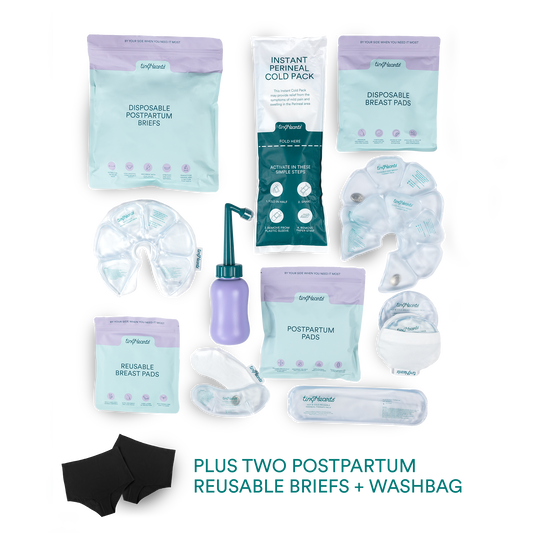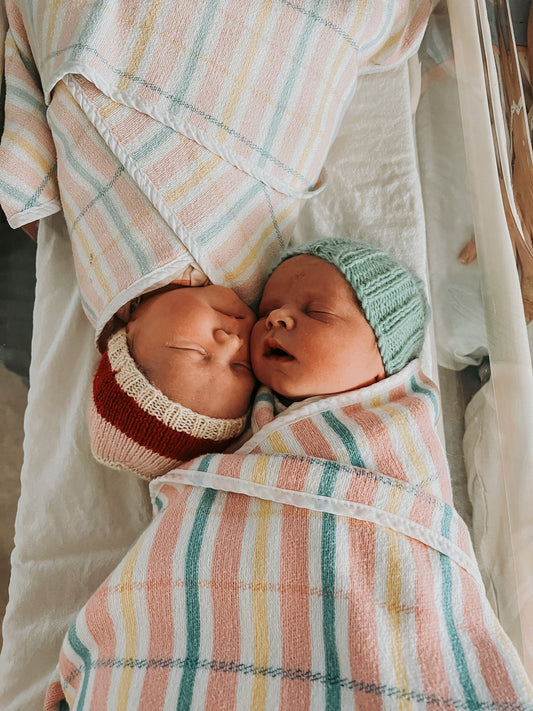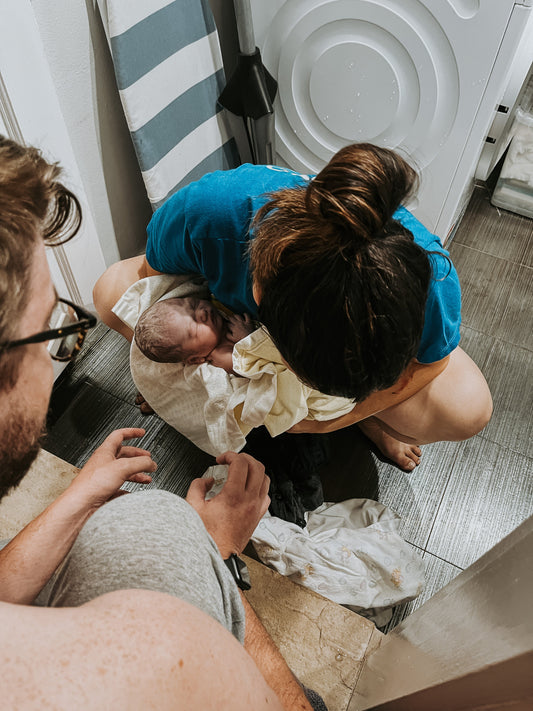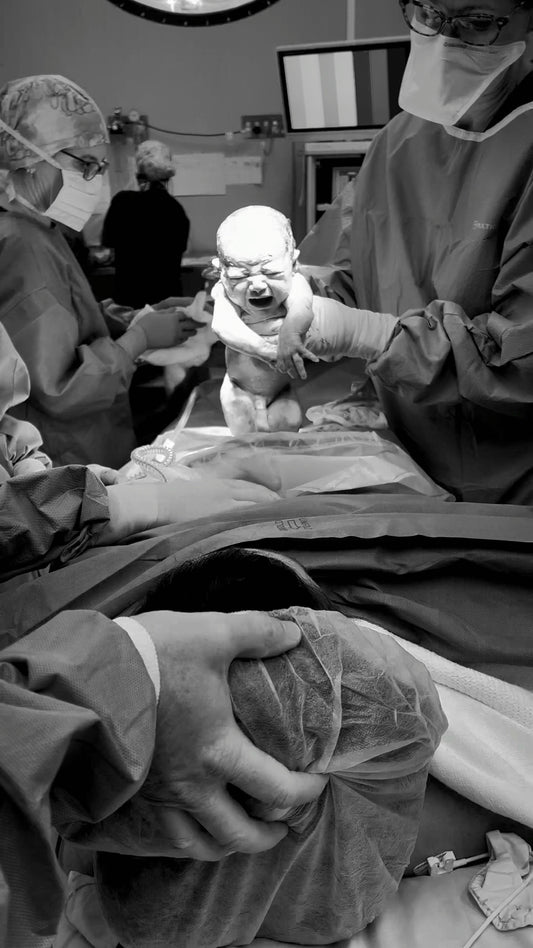Breath-holding + blue spells in little ones is terrifying, so we've written this blog to explain more about blue spells + kiddos holding their breath, so next time you spot your little one experiencing this, you're armed with the info you need to know what to do with confidence.
Breath holding
Breath holding is so so common in little ones + can happen as often as a few times a day for kiddos who are known to have these episodes. Often referred to as a spell, it involves your kiddo [usually aged 6 months to 6 years] holding their breath when they're upset, frightened, hurt or had a minor accident. They will cry, catch their breath, and then "hold it" without breathing. It's not something they do on purpose; more of a reaction. It often begins around 18mo, with most kiddos outgrowing it by the age of 6. Breath holding can be scary and stressful to all involved, but don't panic; this spell is not harmful to your child, and it'll pass quickly, typically only lasting a few seconds. Try to remain calm, take a breath yourself and allow the spell to pass quickly on its own. Avoid shaking your little one or trying to force them to breathe, as this can physically hurt them. And remember, it's usually involuntary, meaning your bub isn't doing it on purpose; they can't control it.
Causes
Doctors still aren't sure of the exact cause of breath-holding. It's thought to be caused by slowing of the heart rate or changes in breathing patterns. It's also thought that they can be triggered by strong emotions, like anger, pain + fear, but there is also a genetic link with a third of kiddos who breath-hold having a family history of it. Interestingly, it's also thought that little ones who do this are more likely to faint as a teen and adult.
Blue Spells vs Pale Spells
There are two main types of breath-holding that can occur in your kiddo; blue or pale spells. While both only last a few seconds, they do have some differences, which we'll go over below. But first, what causes them?
Blue Spells
Blue spells, [AKA: cyanotic breath holding], are the most common. Although uncomfortable to watch, blue spells don't require any treatment, and evidence suggests that they don't cause any long-term damage. They can happen when your child has hurt themselves, has become upset + scared. At the time, you might notice your little one:
- Is or has been crying
- Is or has been screaming
- Forcibly breathes out
- Then they'll turn a pale blue colour [usually around their mouth]
- They may also become floppy or faint
Pale Spells
Pale spells, [AKA: pallid spells] are less common than blue spells and are caused by a slow heart rate. Pale spells are often mistaken for a seizure. At the time, you might notice your little one:
- Opens their mouth as if they're going to cry, but nothing comes out
- Faints
- Looks pale
- Has a very brief period where their arms + legs become stiff
- Potentially loses control of their bladder and/ or bowels
After a blue or pale spell, your kiddo will recover within a matter of seconds but may feel tired afterwards. Some kiddos may also go on to have muscle twitching or a seizure after a prolonged attack.

What to do
This can be a scary time but it will pass quickly! A few things you can do during a breath-holding spell are:
- Stay calm; easy to say I know - but if you're panicking, this can cloud your judgement
- Roll your little one on their side and monitor their airway for the remainder of the spell
- Remove any hazards around them
- Avoid putting anything in their mouth, including water as this is a huge choking risk
- Avoid shaking your bub; this won't encourage them to breathe and hurt them
- Avoid splashing your child with cold water or blowing air in their face as there is no need; they will come to on their own very quickly
When to see a doctor
It's time to take your kiddo to see a doctor if:
- They are having very frequent spells [more than once a day or a few times a week]
- It is the first time this has happened
- Your little one has a seizure after it
- Your little one is acting unusually after the spell
- You notice any other red flag symptoms
- You're concerned
Brue
Another term that you may hear as a parent and is very similar is a BRUE.
What is a BRUE?
BRUE stands for
B: brief
R: resolved
U: unexplained
E: event
BRUE occurs suddenly and can be really scary for parents. The diagnosis of BRUE is made after all possible causes have been excluded and it's determined that there was no known concerning cause for the BRUE occurring.
Signs + symptoms of a BRUE:
In a BRUE, you will notice 1 or more of the following:
- Changes to breathing: decreased, irregular or absent
- Changes to skin colour: pale or blue
- Changes to conscious state: drowsiness or unconscious
- Changes to muscle tone: tight or floppy
What to do?
The answer to that depends on whether BRUE is diagnosed or not. If your little one isn't diagnosed, you need to treat the signs of altered conscious state, breathing problems, skin colour changes and muscle tone changes as an emergency and start DRSABCD as soon as you recognise these changes.
If it really is a BRUE, you will only reach 'airway' before your child returns to a normal conscious state. You should keep an ambulance on the way, stay with your little one + continue to monitor them. Without an official diagnosis of BRUE, you need to treat this situation as an emergency with an unknown cause. The reason for this is that if your little one doesn't return to a normal state, you could have lost precious minutes - so treat it as an emergency until you know otherwise.
Other things your Doctor/ the hospital will try to rule out include:
- Heart + lung disorders
- Metabolic + immune disorders
- Tummy disorders
- Infections
- Viruses Poisoning
Once diagnosed, you'll know how long the episodes last, and you'll be able to closely monitor + begin first aid should the episode differ from what normally happens when your little one has a BRUE. If it's a normal BRUE, you can manage at home + follow the plan provided by the doctor who diagnosed your little one as having had a BRUE.

Newborn breathing
It's important to know that newborns don't have breath-holding episodes. But they are irregular [or periodic] breathers. Babies breathe a lot faster than we do [about 30-60 breathes a minute], and also quite a bit differently. They are big-time nose breathers, and their still-developing lungs and little airways mean they will often take brief pauses between breaths. This can be alarming to observe, but rest assured, it's normal. Although it's more likely in premmie babies, even healthy, full-term bubs up to 6 months of age will have episodes of what we call 'Periodic Breathing.' This is when your little one's breaths pause for less than 10 seconds and then restart, often with several rapid breathes before it returns to normal. These irregular breathing patterns are common when bub is sleeping and in most cases, a part of normal development that they will grow out of as they age.
Periodic breathing is not the same as an apnoea or BRUE, and won't result in a change to your bub's skin colour. If bub is having an apnoea, it's important to perform DRSABCD + seek medical attention. Apnoeas in little ones can be caused by various things, some of which include Whooping Cough + infection, which is why it's important to get bub checked if they are very young and are experiencing breath-holding episodes.
Breathing Monitors
We often get messages from parents asking about breathing monitors, particularly when it comes to sleeping. These are some breathing monitors I know of:
Owlet
A sock-style monitor that wraps onto bub's foot and monitors heart rate, oxygen saturation and if they're in a light or deep sleep. The device will alarm if bub goes outside of the preset ranges for both heart rate and oxygen saturation to wake you into action. If you have wifi, you can connect it to your device to see live readings. However, it's not cheap, and I don't like that you can't customise its "normal" ranges.
Snuza
A monitor that uses motion detection by clipping onto bub's nappy to count breaths per minute, skin temperature and sleeping position. It also alerts if bub stops breathing after 15 seconds, then alarms at 20 seconds. It can send live readings to your device using Bluetooth, and you can change the "normal" ranges of breaths. With this, there can be false alarms if it slips off bub's nappy, and it's not cheap either.
Breathing pads These work on motion detection under bub's mattress and alert if breathing movement slows to <10 breaths/ minute or isn't detected for 20 secs. If bub wriggles off, it may sound a false alarm or may falsely detect breathing from an overhead fan.
It's important for any parents considering this to know that Red Nose tells us that currently, there's no research saying a breathing monitor will prevent SIDS. These devices don't save your bub's life if they stop breathing; they simply alert you to it. If it ever happened, you would still need to provide CPR until the ambulance arrived. So ask yourself, am I buying this to be alerted or am I buying this to save my bub's life?
If it's the latter, the device simply doesn't do that; but you can. Our Baby First Aid course will give you the skills I hope you never need to use to step up + save your precious Tiny Heart.
Helping you feel prepared for parenthood is what Tiny Hearts is all about. Book into our baby + child first aid class, and let us empower you to face parenthood without fear. 💗
Online baby & child first aid
$150
Learn baby & child first aid from your device at home! Purchase now and learn right away.
Our instant access course includes over 38 videos and 15 bonus downloads including content on whooping cough, croup and more!








